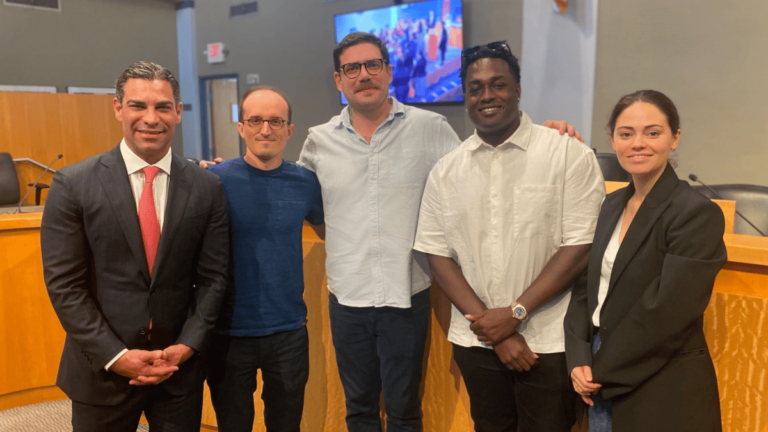Key Insights
- Phases one and two of staking went live. Users can now stake HBAR with Hedera nodes but do not receive staking rewards. Additionally, Hedera open-sourced the codebase.
- Hedera Governing Council Member LG announced the launch of LG Art Lab, an NFT marketplace built on Hedera that will enable LG SmartTV owners to discover, buy, and sell Hedera NFTs directly from their TVs.
- Network-wide activity increased with the launch of the first DEX SaucerSwap and NFT activity hit all-time-highs.
- The Hedera Network Services yielded mixed results. The Smart Contract Service had explosive growth while the Consensus Service remained significantly down from 2021.
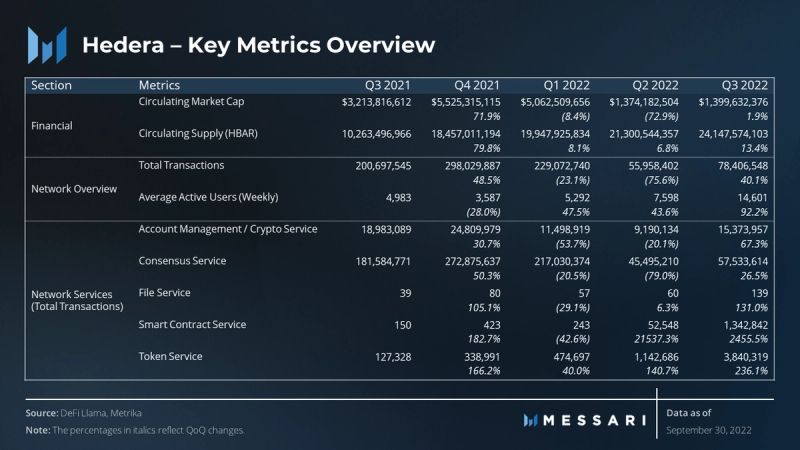
Primer on Hedera
Hedera is a public-permissioned Proof-of-Stake (PoS) blockchain network. It is governed by 26 global enterprises, known as the Hedera Governing Council, with input from the community via Hedera Improvement Proposals (HIPs). Members of the Governing Council operate Hededra’s validator nodes as the network transitions to permissionless node hosting. Hedera offers developers core services, known as the Hedera Network Services, to build decentralized applications. The network is powered by the Hashgraph Consensus Algorithm, which offers high throughput, fair ordering, and low-latency consensus.
Performance Analysis
Financial and Network Overview
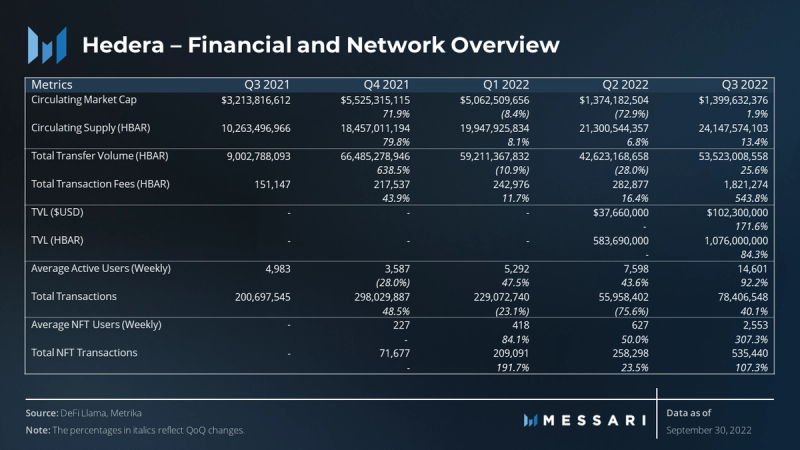
Following a tumultuous second quarter, the Hedera Network rebounded with strong growth across the board. During Q3, Hedera’s market capitalization was relatively flat QoQ, transfer volume was up 25% QoQ, and DeFi and NFT metrics made all-time-highs.
The increases in activity are attributed to multiple factors. The first decentralized exchange, SaucerSwap, went live. The top NFT marketplaces continued to increase their NFT market share. The HBAR foundation committed $360 million to ecosystem projects. Overall, Q3 was a strong quarter for the network, as it continues to build and expand during the bear market.
DeFi

Hedera ended Q3 with $100 million in TVL (171% increase QoQ). The increase in TVL was primarily driven by the launch of Hedera’s first decentralized exchange, SaucerSwap. In the two months since launch, Saucer has reached over $17 million in TVL and $30 million in transaction volume. Stader Labs, a liquid staking platform, is responsible for the majority of the network’s TVL, ending Q3 with $80 million of the $100 million total network TVL.
NFT Ecosystem
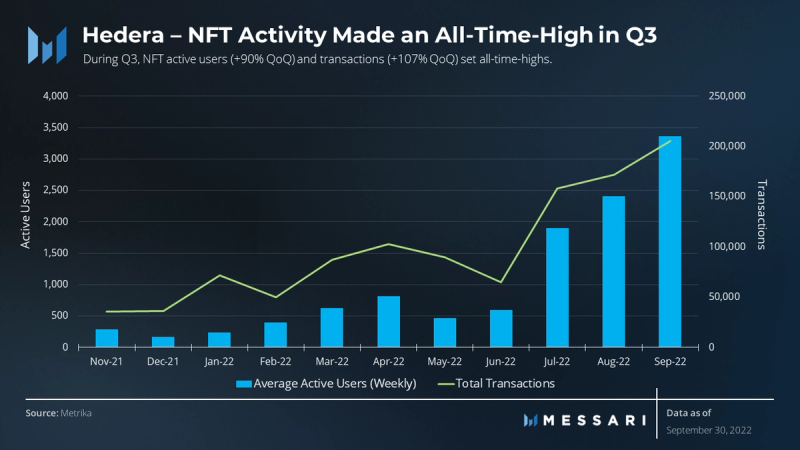
The Hedera NFT sector (a component of the Hedera Token Service) has been an engine of growth for the network. During Q3, NFT active users (+90% QoQ) and transactions (+107% QoQ) each set all-time-highs. NFT activity began rising in February 2021, following the launch of the Hedera Smart Contract Service 2.0 and its integration with the Hedera Token Service. Around the same time, the first NFT marketplaces Hash Axis and Zuse Market launched. Since genesis, over 300,000 NFTs have been minted.
Similar to DeFi, NFT activity is dominated by two applications:
- Hash Axis – An NFT marketplace using HIP-412 standards (meaning the token is ERC-721 compatible) for minting NFTs. Hash Axis has 300 weekly active users and over 50,000 total transactions.
- Zuse Market – An NFT marketplace and launchpad. Zuse has facilitated over 73 million in total trading volume in HBAR terms.
In September 2022, Hedera Governing Council Member LG announced the launch of the LG Art Lab. Another contributor to the strong quarter, the lab is an NFT marketplace platform built on Hedera, which will enable LG SmartTV owners to discover, buy, and sell NFTs on Hedera directly from their TVs. By integrating the LG Art Lab platform with its SmartTV products, LG is exclusively using Hedera to bring NFTs to its millions of global users.
Despite the potential for broader adoption, Hedera NFT activity still trails leading ecosystems Ethereum and Solana by a wide margin. During the third quarter, Ethereum registered 3 million transactions and Solana 6 million transactions, compared to 540,000 on Hedera.
Gaming
The Hedera gaming sector remains a nascent part of the ecosystem; however, there are some notable developments. Liithos, a newly formed AAA gaming and entertainment studio led by PlayStation veterans, announced that it has begun working on its debut title, Ashfall. The post-apocalyptic survival adventure game was built utilizing Hedera. Slime World, a popular play-to-earn game on Hedera, surpassed 100,000 unique users during the quarter. Finally, the HBAR Foundation announced it is funding multiple games including Meta Wizards, OneTo11, Vavelverse, and Music Battles.
Hedera Network Services Overview
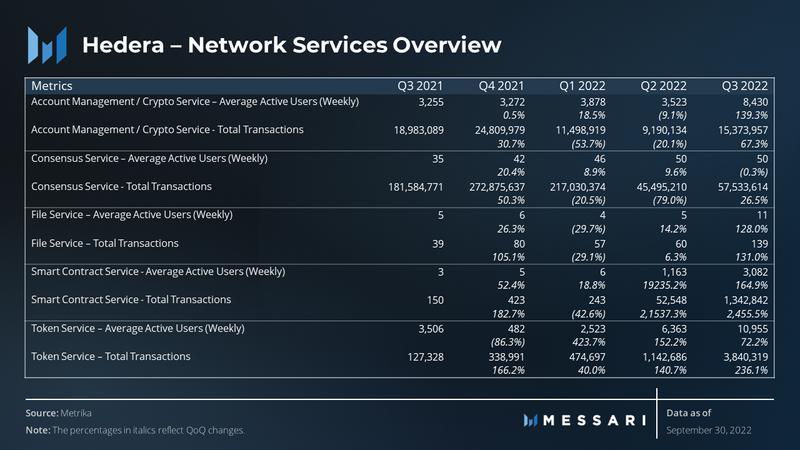
The Hedera Network Services are the core offerings of the Hedera Network. The services allow users to create accounts, mint tokens, write data to the ledger, call smart contracts, and perform a host of other functions directly from a set of APIs. The Network Services are supported by the Hashgraph algorithm, use the fixed fee structure, and offer Software Development Kits (SDKs) to access the API via popular programming languages like JavaScript, Java, and Go.
The primary users and the frequency with which they use the Network Services vary across the different service offerings and use cases. Today, the Hedera Consensus Service is primarily used by enterprises, while the Hedera Crypto Service, File Service, Smart Contract Service, and Token Service are primarily used by developers and retail. However, developers, enterprises, and retail use each of the services. Therefore, the different primary users of each service result in highly skewed, yet predictable, consumption patterns.
Overall, the Hedera Network Services yielded mixed results during Q3. The services with the largest gains were the Account Management / Crypto Service, the Smart Contract Service, and the Token Service. The increases were primarily due to the launch of the first decentralized exchange, SaucerSwap. Saucer used the combination of these services to power the entire application.
Hedera Account Management / Crypto Service

The Hedera Account Management / Crypto Service is used to perform basic functions across the Hedra Network. These functions include fungible and non-fungible token transfers, account creations, account updates, account clearings, and account allowance approvals. During Q3, the Hedera Crypto Service set an all-time-high in weekly active users. The increase was mainly driven by the launch of Hedera’s first decentralized exchange, SaucerSwap. Additionally, smaller protocols like the domain service Web23 and name service Hashgraph.name went live. Overall, the Crypto Service accounts for 37% of active users and 20% of total transactions.
Hedera Consensus Service
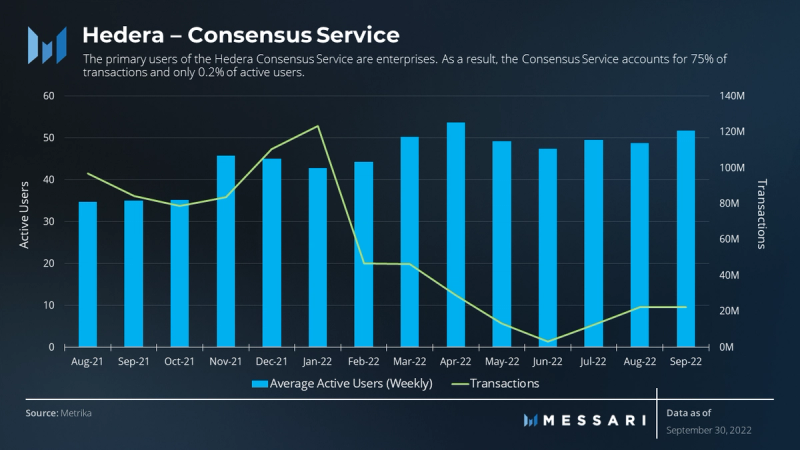
The Hedera Consensus Service provides verifiable time-stamping and ordering of events for Web2 and Web3 applications. Users submit messages to the Hedera Network where the messages are ordered and time-stamped by the Hashgraph algorithm. Over time, the messages form an auditable history of verifiable, trustless events. The Consensus Service is used by applications to track provenance across supply chains, log asset transfers between blockchain networks, count votes in a DAO, monitor IoT devices, and more.
The primary customers of the Consensus Service are enterprises that utilize the service for core business functions. For example, Avery Dennison is integrating the Consensus Service into its cloud platform to account for customer carbon emissions. As a result of the enterprise-centric user base, the Consensus Service accounted for 75% of total transactions and only 0.2% of active users. Over the last year, Consensus Service transaction volume is down 79% from the Q4 2021 high of 273 million transactions. The drop occurred after a single user, responsible for pushing a significant amount of transactions, lost many of their clients, which led to an outsized impact.
Hedera File Service

The Hedera File Service stores smart contract data, credentials, and other critical files on the Hedera Network. Of all the Network Services, the Hedera File Service is the least adopted. The low adoption is due to the unique architecture of Hedera, which does not store all data on-chain (unlike more traditional blockchains). Over the last five quarters, the Hedera File Service has accounted for less than 0.01% of active users and total transactions on the network.
Hedera Smart Contract Service

The Hedera Smart Contract Service allows developers to build and deploy smart contracts to power applications. It offers no congestion fees for gas, certainty of cost, and integration with the Hedera Token Service to easily create and deploy fungible and non-fungible tokens. Naturally, the primary customers of the Smart Contract Service are developers.
In February 2022, the launch of Smart Contracts 2.0 brought EVM compatibility, Solidity-based smart contract functionality, and core Ethereum tooling support to the service. The next quarter, activity exploded with weekly active users increasing from 5-1,100 and total transactions increasing from 240-50,000. During Q3 2022, the growth accelerated with an average of 3,000 weekly active users and 1.3 million transactions. Overall, the smart contract service accounts for 14% of active users and 2% of total transactions of the network.
During Q3 2022, Hedera announced two additional updates to smart contracts: smart contract rent and bundling API fees with gas fees. The smart contract rent will act as a renewal fee for smart contracts. The expectation is that the rent will cost approximately $0.02 per key-value pair (denominated in HBAR). Developers can pay the renewal fees from the relevant contract or an external account. The bundling of API fees into gas fees removes the need to pay separate API call and gas fees.

The Hedera Token Service enables anyone to configure, mint, and manage native fungible and non-fungible tokens on the Hedera network. The primary customers of the Token Service are developers and retail users. Additionally, there are some enterprise users including:
- eftpos Payment Australia – a micro-payment proof-of-concept that aims to create a seamless Australian payment experience for web users by providing an alternative to traditional online paywalls and subscriptions.
- DLA Piper – a platform to issue NFTs representing various asset classes such as real estate, fine art, intellectual property, ESG, debt restructuring, fund structuring, equity / digital IPO, and reinsurance on its digital asset creation engine.
- Suku – an NFT platform that incorporates digital identity into physical tags to increase trust between brands, customers, and secondary market participants. It also aims to reduce counterfeit fraud in secondary marketplaces
Of all the Hedera Network Services, the Hedera Token Service saw some of the highest levels of growth, primarily driven by the increase in NFT activity. During Q3, the Hedera Token Service accounted for approximately 50% of the active users and 5% of total transactions.
Qualitative Analysis
Governance

The Hedera Governance Council is an elected group of organizations supporting the development and growth of Hedera. The Governance Council currently has 26 members out of a maximum of 39, and each member has an equal vote in the direction of Hedera. Council members currently operate the Hedera validator nodes. However, at scale, Hedera anticipates thousands of permissionless public nodes supporting the network. Going forward, all members have a three-year term, with up to two consecutive terms and an equal vote on network and platform decisions. Swirlds, the creator of Hashgraph, has a permanent seat but no other special rights. The Council is primarily focused on decentralized governance of the network to ensure stability and management of the Hedera Treasury.
The Council holds a monthly meeting and publishes minutes from the meeting.
- July meeting – The Council members approved the transfer of 2.35 billion HBAR from Hedera’s Treasury to staff-controlled administrative accounts to meet potential coin distribution obligations in H2 2022. The requested allocation assumes a $0.04 HBAR price. Thus, it is not likely the case that the full allocated number of coins will be distributed.
- August meeting – The Council members approved the appointment of Bill Miller from Swirlds as co-chair of the Membership Committee, Rich Widmann from Google as co-chair of the Legal & Regulatory Committee, and Saiprasad Raut from FIS/Worldpay as co-chair of the Corporate Utilization Committee. The Council members approved the provision of an aggregate payment of $200,000 worth of HBAR as remuneration to three Board members for their service in 2020 and 2021. This approval occurred before the establishment of a Board Compensation Policy.
- September meeting – The Council members approved the proposed Board Compensation Policy, which would compensate a Board member up to $250,000 worth of HBAR a year upon satisfying performance obligations related to meeting attendance and other forms of participation.
Community members can participate in governance via Hedera Improvement Proposals (HIPs). These improvement proposals can range from core protocol changes, to changes to the applications, frameworks, and protocols built on top of the Hedera public network and used by the community. The HIP author is responsible for building consensus within the community, documenting dissenting opinions, and tracking their HIP through the process.
During Q3, HIP-329: CREATE2 went live on mainnet. HIP-329 enabled the deterministic deployment of smart contracts, the ability to use an address before the smart contract is deployed, and the ability for smart contracts to natively interact with the Hedera Token Service. SaucerSwap stated “we wouldn’t have been able to build our DEX without CREATE2. In our view, this was a key development for Hedera in the last few months, and now that HTS tokens interact seamlessly with fully-fledged smart contracts, the power of the network has begun to be fully unleashed.”
Staking
Currently, Hedera validator nodes are operated by members of the Hedera Governing Council, and each validator node has an equal stake. For the network to transition to permissionless node hosting, non-council member nodes must retain the ability to participate in consensus. Similarly, community members need to have the ability to choose which nodes they support.
On June 3, 2022, the latest step in further decentralization was completed with the passing of HIP-406: Staking. The detailed proposal outlined the goals, parameters, and steps necessary for Hedera to transition to a community-enabled Proof-of-Stake (PoS) network. In late July, phases one and two of a four-phase staking rollout went live:
- Phase-1 Technical Availability – Users can stake their HBAR with mainnet nodes, but it does not contribute to the node’s consensus weight. Users are not rewarded for staking.
- Phase-2 Ecosystem Development – Supported exchanges and wallets can integrate the staking functionality to provide account holders an easy way to stake their HBAR. Users’ stake with a node will affect its consensus weight, but staking rewards will not be enabled.
- Phase-3 Staking Rewards and Program Launch – The Hedera Governing Council has decided the ecosystem is ready to enable staking rewards. The Council voted to implement a maximum cap of 6.5% annual staking yield. Once the threshold of 250 million HBAR has been met, and sufficient ecosystem support has been implemented, the network will begin distributing rewards.
- Phase-4 Complete Staking Implementation – Staking functionality is completed by enabling 24-hour updates for node staking visibility.
Some additional points surrounding staking include no minimum delegated staking requirement, a minimum delegated staking period of 24 hours, validator stake minimum and maximum thresholds set by network demand, and that 100% of staking rewards go to accounts staking.
Closing Summary
Following a historical second quarter, Hedera had a strong third quarter. During Q3, Hedera’s market capitalization was relatively flat while key performance indicators across network financials, network activity, and the Hedera Network Services were generally positive QoQ.
The increase in Hedera’s financial and network performance was primarily driven by the launch of its first decentralized exchange, SaucerSwap, and the continued growth of leading NFT marketplaces. In the two months since launch, SaucerSwap has amassed over $17 million in TVL and $30 million in transaction volume, making it the second largest application by TVL on Hedera. Stader, the leading application by TVL, accounts for $80 million in TVL. Concurrently, Hedera’s NFT sector set all-time-highs in active users (+90% QoQ) and transactions (+107% QoQ). A contributor to the growth was Hedera Governing Council member LG announcing the launch of LG Art Lab – an NFT marketplace platform built on Hedera that will enable LG SmartTV owners to discover, buy, and sell NFTs on Hedera directly from their TVs.
The Hedera Network Services yielded mixed results during Q3. The services with the largest increases were the Account Management / Crypto Service, the Smart Contract Service, and the Token Service. The launch of SaucerSwap, again, primarily accounted for the increases. The Consensus Service remains significantly down from all-time-highs (-79%), while the File Service continues to have minimal adoption.
The Hedera Network took another step towards decentralization with the formal launch of phase-one and phase-two staking. Users can now stake HBAR with Hedera nodes but do not receive staking rewards. Hedera will follow a four-phase staking roadmap. Additionally, Hedera formally open-sourced the code.
Overall, Q3 was a strong quarter for Hedera as it continues to build and expand during the bear market. The HBAR Foundation has 167 grants and $360 million committed, so expect additional applications to continue coming online over the upcoming quarters. The base-layer space is becoming increasingly competitive.
Let us know what you loved about the report, what may be missing, or share any other feedback by filling out this short form.
This report was commissioned by the HBAR Foundation, a member of Protocol Services. All content was produced independently by the author(s) and does not necessarily reflect the opinions of Messari, Inc. or the organization that requested the report. Paid membership in Protocol Services does not influence editorial decisions or content. Author(s) may hold cryptocurrencies named in this report. Crypto projects can commission independent research through Protocol Services. For more details or to join the program, contact ps@messari.io. This report is meant for informational purposes only. It is not meant to serve as investment advice. You should conduct your own research, and consult an independent financial, tax, or legal advisor before making any investment decisions. The past performance of any asset is not indicative of future results. Please see our Terms of Use for more information.

